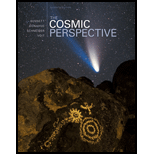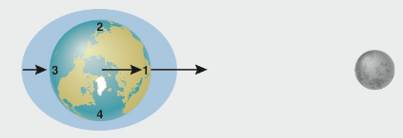
The Cosmic Perspective
7th Edition
ISBN: 9780321839558
Author: Jeffrey O. Bennett, Megan O. Donahue, Nicholas Schneider, Mark Voit
Publisher: Addison-Wesley
expand_more
expand_more
format_list_bulleted
Textbook Question
Chapter 4, Problem 3VSC
Use the following questions to check your understanding of some of the many types of visual information used in astronomy. For additional practice, try the Chapter 4 Visual Quiz at MasteringAsrrononry®.

The figure above, based on figure 4.24, shows how the Moon causes tides on Earth. Note that the North Pole is in the center of the diagram, so the numbers 1 through 4 label points along Earth's equator.
3. Where is it low tide?
a. point 1 only
b. point 2 only
c. points 1 and 3
d. points 2 and 4
Expert Solution & Answer
Want to see the full answer?
Check out a sample textbook solution
Students have asked these similar questions
No Chatgpt please
A construction crane with a 42m long horizontal arm carries a load of 5000kg,which is suspended from a trolley that runs along the length of the arm. Thecrane rotates with angular velocity of 0.15 s^-1 . The trolley pulls the load towards the axis of thecrane with a constant horizontal velocity of 0.2m/s relative to the arm. Determinethe magnitude and direction of the Coriolis force acting on the load due to therotation of the crane (the Earth's rotation can be neglected)
The sport Hammer Throw involves a "hammer", which consists of a metal ballattached by a steel wire to a grip. For women, the mass of the ball is 4kg (themass of the steel wire and grip are negligible), and the length of the steel wire is120 cm. Calculate the magnitude of the centrifugal force that acts on the ball fora woman with 50cm long arms, who spins on the spot with an angular velocity of 4(pi)s^-1
Chapter 4 Solutions
The Cosmic Perspective
Ch. 4 - Prob. 1VSCCh. 4 - Use the following questions to check your...Ch. 4 - Use the following questions to check your...Ch. 4 - Use the following questions to check your...Ch. 4 - Use the following questions to check your...Ch. 4 - Define speed, velocity, and acceleration. What are...Ch. 4 - Define momentum and force. What do we mean when we...Ch. 4 - What is free-fall, and why does it make you...Ch. 4 - Prob. 4EAPCh. 4 - Describe the laws of conservation of momentum, of...
Ch. 4 - Define kinetic energy, radiative energy, and...Ch. 4 - Define temperature and thermal energy. How are...Ch. 4 - Prob. 8EAPCh. 4 - 9. Summarize the universal law of gravitation both...Ch. 4 - 10. What is the difference between a bound and an...Ch. 4 - What do we need to know if we want to measure an...Ch. 4 - Explain why orbits cannot change spontaneously,...Ch. 4 - Explain how the Moon creates tides on Earth. Why...Ch. 4 - What is tidal friction? What effects does it have...Ch. 4 - Does It Make Sense?
Decide whether the statement...Ch. 4 - Does It Make Sense?
Decide whether the statement...Ch. 4 - Does It Make Sense?
Decide whether the statement...Ch. 4 - Does It Make Sense?
Decide whether the statement...Ch. 4 - Prob. 19EAPCh. 4 - Prob. 20EAPCh. 4 - Does It Make Sense? Decide whether the statement...Ch. 4 - Does It Make Sense?
Decide whether the statement...Ch. 4 - Does It Make Sense?
Decide whether the statement...Ch. 4 - Does It Make Sense?
Decide whether the statement...Ch. 4 - Choose the best answer to each of the following....Ch. 4 - Choose the best answer to each of the following....Ch. 4 - Choose the best answer to each of the following....Ch. 4 - Choose the best answer to each of the following....Ch. 4 - Choose the best answer to each of the following....Ch. 4 - Prob. 30EAPCh. 4 - Prob. 31EAPCh. 4 - Choose the best answer to each of the following....Ch. 4 - Choose the best answer to each of the following....Ch. 4 - Choose the best answer to each of the following....Ch. 4 - Testing Gravity. Scientists are continually trying...Ch. 4 - Prob. 36EAPCh. 4 - Prob. 37EAPCh. 4 - Prob. 38EAPCh. 4 - Gravitational Potential Energy. For each of the...Ch. 4 - Prob. 40EAPCh. 4 - Prob. 41EAPCh. 4 - Prob. 42EAPCh. 4 - Prob. 43EAPCh. 4 - Prob. 44EAPCh. 4 - Geostationary Orbit. A satellite in geostationary...Ch. 4 - Prob. 46EAPCh. 4 - Prob. 47EAPCh. 4 - Prob. 48EAPCh. 4 - Prob. 49EAPCh. 4 - Prob. 50EAPCh. 4 - Prob. 51EAPCh. 4 - Prob. 52EAPCh. 4 - Prob. 53EAPCh. 4 - Prob. 54EAPCh. 4 - Prob. 55EAPCh. 4 - Prob. 56EAPCh. 4 - Prob. 57EAPCh. 4 - Prob. 58EAPCh. 4 - Prob. 59EAPCh. 4 - Prob. 60EAPCh. 4 - Prob. 61EAP
Knowledge Booster
Learn more about
Need a deep-dive on the concept behind this application? Look no further. Learn more about this topic, physics and related others by exploring similar questions and additional content below.Similar questions
- An AC voltage source is connected to an inductor with inductance 0.047 H. The voltage source provides a time-dependent voltage V across the inductor as described by V(t) = v0 sin(ωt), where v0 = 251 V and ω = 991 rad/s. a) Find the current through the inductor, in amperes with its sign, at time t = 1.9 s. b) Calculate the instantaneous power, in watts with its sign, that the inductor is absorbing at time t = 1.9 s.arrow_forwardI need help with my physics practice problem. Can some one go through this and show all the steps detial by detail? and fill out the final table?arrow_forwardA standing wave can be created when a disturbance (wave) is trapped between two boundaries. Thus, standing sound wave can be produced when gas is confined in long narrow tube closed at both ends. In addition, standing waves can be produced in tubes with an opening at one end of the tube as well (open-closed tube). The eardrum can be modeled as an open-closed tube. The ear canal in adults is about 2.5 cm in length. Thus, what frequency ranges can occur in the ear canal that are within the range of human hearing? In other words, what is the fundamental frequency of the ear canal? The speed of sound in the warm air of the ear canal is 350 m/s. Hint: Wavelength of standing waves in open-closed tubes are given by the following: λ = 4L where m = 1,3,5,7 marrow_forward
- A cardiologist reports to her patient that he radius of the left anterior descending artery of the heart has narrowed by 10.0%. What is the percent increase in the blood pressure drop across the artery that is required to maintain the normal blood flow through artery? Hint: To main normal blood flow, the blood volume flow rate must remain the same (Qnormal = Qdecreased). Poiseuille's Law gives the equation for volume flow rate of a viscous fluid. Please review Chapter 11 and continuity equation.arrow_forwardThe heart pumps blood into the aorta, which has an inner radius of 1.0 cm. The aorta feeds 32 major arteries. If the blood in the aorta travels at a speed of 28 cm/s, at approximately what average speed in units of m/s does it travel in the arteries? Assume that blood can be treated as an ideal fluid and that the arteries each have an inner radius of 0.21 cm.arrow_forwardA standing wave can be created when a disturbance (wave) is trapped between two boundaries. Thus, standing sound wave can be produced when gas is confined in long narrow tube closed at both ends. In addition, standing waves can be produced in tubes with an opening at one end of the tube as well (open-closed tube). The eardrum can be modeled as an open-closed tube. The ear canal in adults is about 2.5 cm in length. Thus, what frequency ranges can occur in the ear canal that are within the range of human hearing? In other words, what is the fundamental frequency of the ear canal? The speed of sound in the warm air of the ear canal is 350 m/s. Hint: Wavelength of standing waves in open-closed tubes are given by the following: A: 4L where m = 1,3,5,7 marrow_forward
- 7) A cylindrical superconductor (type I with a penetration depth of 200 nm) of radius 0.2 m has an axial hole in the center of radius 0.1 m. The superconductor is field cooled with 3 Tesla (field is applied before cooling completed). a) What is the ratio of the flux stored in the hole to the superconducting region when it is cooled to 30 Kelvin, well below Tc = 90 Kelvin. b) What is the value of the current density on the outside and on the inside surfaces?arrow_forwardProblem 2 Determine the moments of inertia Į and I of the area shown with respect to y centroidal axes respectively parallel and perpendicular to side AB. A 42 mm 28 mm B 36 mmarrow_forwardProblem 1 Determine the moments of inertia I and I, of the area shown with respect to centroidal axes respectively parallel and perpendicular to side AB. 1.2 in. 5.0 in. 1.8 in. 0.9 in. 2.0 in. 2.1 in. Barrow_forward
- Problem 7 6-49. Determine the maximum tensile and compressive bending stress in the beam if it is subjected to a moment of M- 4 kip.ft. 0.5 in 0.5 in 3 in. 10 in. D -0.5 in. B -0.5 in.arrow_forwardProblem 4 *4-2. The copper shaft is subjected to the axial loads shown. Determine the displacement of end A with respect to end D if the diameters of each segment are dAB 0.75 in., dBC = 1 in., and dcp = 0.5 in. Take Ecu = 18(103) ksi. -80 in.- -150 in.- -100 in.- 5 kip 2 kip 8 kip 6 kip A 5 kip B C 2 kiparrow_forwardProblem 8 For the given beam draw the diagrams of shear force and bending moment, and determine the maximum normal stress due to bending. 800 lb/in. 1 in. A 20 in.- B 8 in. T C 3 in. H 2½ in.arrow_forward
arrow_back_ios
SEE MORE QUESTIONS
arrow_forward_ios
Recommended textbooks for you
 College PhysicsPhysicsISBN:9781305952300Author:Raymond A. Serway, Chris VuillePublisher:Cengage Learning
College PhysicsPhysicsISBN:9781305952300Author:Raymond A. Serway, Chris VuillePublisher:Cengage Learning University Physics (14th Edition)PhysicsISBN:9780133969290Author:Hugh D. Young, Roger A. FreedmanPublisher:PEARSON
University Physics (14th Edition)PhysicsISBN:9780133969290Author:Hugh D. Young, Roger A. FreedmanPublisher:PEARSON Introduction To Quantum MechanicsPhysicsISBN:9781107189638Author:Griffiths, David J., Schroeter, Darrell F.Publisher:Cambridge University Press
Introduction To Quantum MechanicsPhysicsISBN:9781107189638Author:Griffiths, David J., Schroeter, Darrell F.Publisher:Cambridge University Press Physics for Scientists and EngineersPhysicsISBN:9781337553278Author:Raymond A. Serway, John W. JewettPublisher:Cengage Learning
Physics for Scientists and EngineersPhysicsISBN:9781337553278Author:Raymond A. Serway, John W. JewettPublisher:Cengage Learning Lecture- Tutorials for Introductory AstronomyPhysicsISBN:9780321820464Author:Edward E. Prather, Tim P. Slater, Jeff P. Adams, Gina BrissendenPublisher:Addison-Wesley
Lecture- Tutorials for Introductory AstronomyPhysicsISBN:9780321820464Author:Edward E. Prather, Tim P. Slater, Jeff P. Adams, Gina BrissendenPublisher:Addison-Wesley College Physics: A Strategic Approach (4th Editio...PhysicsISBN:9780134609034Author:Randall D. Knight (Professor Emeritus), Brian Jones, Stuart FieldPublisher:PEARSON
College Physics: A Strategic Approach (4th Editio...PhysicsISBN:9780134609034Author:Randall D. Knight (Professor Emeritus), Brian Jones, Stuart FieldPublisher:PEARSON

College Physics
Physics
ISBN:9781305952300
Author:Raymond A. Serway, Chris Vuille
Publisher:Cengage Learning

University Physics (14th Edition)
Physics
ISBN:9780133969290
Author:Hugh D. Young, Roger A. Freedman
Publisher:PEARSON

Introduction To Quantum Mechanics
Physics
ISBN:9781107189638
Author:Griffiths, David J., Schroeter, Darrell F.
Publisher:Cambridge University Press

Physics for Scientists and Engineers
Physics
ISBN:9781337553278
Author:Raymond A. Serway, John W. Jewett
Publisher:Cengage Learning

Lecture- Tutorials for Introductory Astronomy
Physics
ISBN:9780321820464
Author:Edward E. Prather, Tim P. Slater, Jeff P. Adams, Gina Brissenden
Publisher:Addison-Wesley

College Physics: A Strategic Approach (4th Editio...
Physics
ISBN:9780134609034
Author:Randall D. Knight (Professor Emeritus), Brian Jones, Stuart Field
Publisher:PEARSON
Time Dilation - Einstein's Theory Of Relativity Explained!; Author: Science ABC;https://www.youtube.com/watch?v=yuD34tEpRFw;License: Standard YouTube License, CC-BY